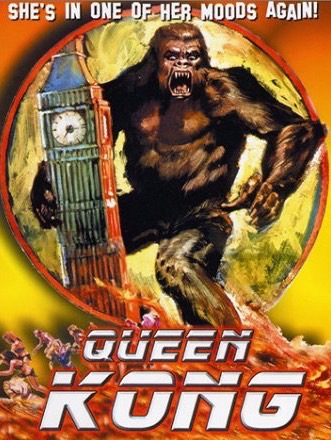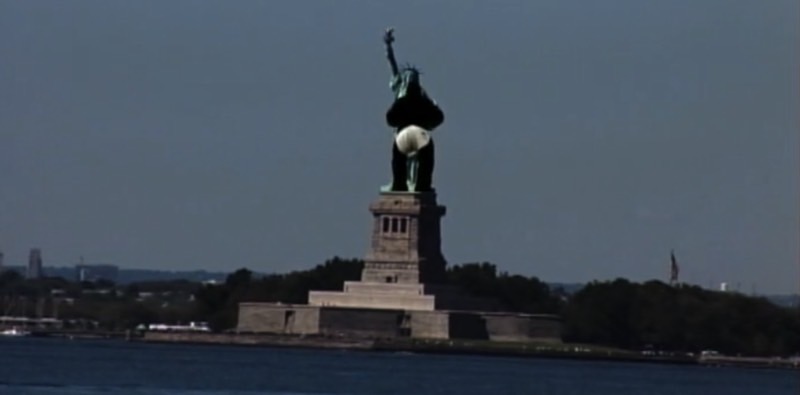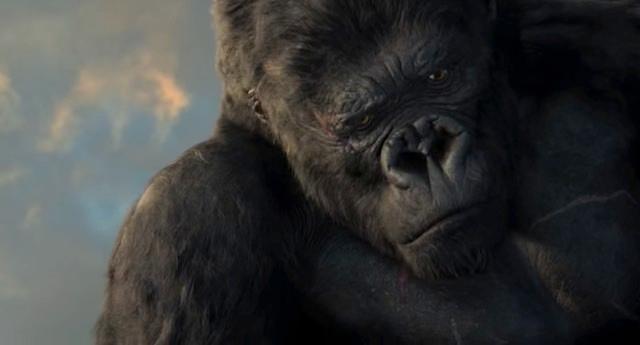Kong: Skull Island is out March 10, the latest showcase for one of cinema’s oldest and most reliable icons. Everyone knows about the 1933 original film, and the 2005 remake isn’t too distant of a memory. But what else has Hollywood’s hairiest superstar spent the last 84 years doing? We take a look back.
A King Is Born
King Kong first thrilled audiences in 1933, the big-screen culmination of a long-held dream by Merian C. Cooper — heroic military pilot, world-travelling journalist, and ambitious Hollywood player. Cooper had been fascinated by the idea of a giant gorilla since his early years growing up in Jacksonville, Florida, and inspiration struck one day while he was on hiatus from his movie career, working for Pan American Airways in New York City. Why not combine that giant gorilla with the city’s most iconic skyscraper, and throw in some aeroplanes for good measure?
In Cooper’s film, the huge ape — brought to life by Willis O’Brien’s remarkable stop-motion effects — dwells on the mysterious Skull Island, somewhere near Indonesia, where dinosaurs and giant insects also roam. He’s pursued by filmmaker Carl Denham (Robert Armstrong), who was based on Cooper, and falls for Ann Darrow (Fay Wray), the comely blonde who eventually accompanies him up the Empire State Building.
Though Kong dies at the end (the film’s most famous line, of course: “It was Beauty, killed the Beast”), audiences went nuts over the film, and most movie critics did too. A contemporaneous New York Times writer, reporting in after a sold-out show at Radio City Music Hall, observed that “this picture was received by many a giggle to cover up fright.” Kong was an overnight superstar.
Since Hollywood has always known the importance of cashing in on one’s hot property, an insta-sequel followed: 1933’s Son of Kong, helmed by Cooper’s King Kong co-director Ernest B. Schoedsack. In Son of Kong, Denham (Armstrong again) returns to Skull Island on a treasure hunt and meets “Little Kong” — a smaller, much jollier, ultimately way less compelling version of his father. Box office success did not repeat.
But the King’s lasting impact couldn’t be denied. The character inspired at least two Japanese silent films in the years immediately following, a 1933 comedy (in which a stage performer in an ape costume is mistaken for the real thing) and a 1938 drama (featuring a pet ape played by an actor in a costume). Both films are now lost, but King Kong would return to Japan — and to America. Many, many times.
Pretenders to the Crown
Schoedsack and Cooper teamed up for 1949’s Mighty Joe Young, another giant ape tale (with special effects by O’Brien and a young Ray Harryhausen) that starred Armstrong as a man who thinks gorillas should perform in nightclubs. (It was remade in 1998.) But though Mighty Joe was certainly influenced by King Kong… he wasn’t King Kong. And neither was the beast in 1961’s Konga, a British monster movie that blatantly rips off its biggest influence while also being kinda charmingly cheesy in its own right.
In 1976, another British monster movie riffed on Kong — this time with a deliberate comedic angle, not to mention a complete gender-swap of all the roles from the original.

It’s… certainly something.
The O.G. comeback
Queen Kong, of course, would not have happened without 1976’s giant-ape main event: superproducer Dino De Laurentiis’ King Kong, a somewhat faithful remake of the 1933 original. It’s more lighthearted tone has been tempered since the climactic ascent at the end takes place at the World Trade Center, a relatively new NYC landmark at the time. The effects team led by Carlo Rambaldi won an Oscar (the guy who actually wore the ape suit, Rick Baker, went on to have his own Oscar-winning career in special effects), and though critical reception was mixed, King Kong once again proved to be a box office hit. This time, however, it took 10 years to produce a poorly-received sequel: 1986’s King Kong Lives.
After that flop, it would take nearly 20 years (and some major legal wrangling over the character) for King Kong to get another proper blockbuster treatment, courtesy of a post-Lord of the Rings Peter Jackson. He was, of course, the perfect director to tell the story using 2005’s most sophisticated special effects — as well as the performance-capture acting skills of Andy Serkis, who played Kong. Serkis’ fellow Planet of the Apes chimp, Toby Kebbell, has taken on the role for Skull Island — and, presumably, all the sequels Legendary has planned as part of its MonsterVerse. (it giant monster cinematic universe, not to be confused with Universal’s classic monster-verse, although it absolutely will be).
Reign in Japan
One of those upcoming MonsterVerse flicks is the rematch, if not the remake, that we’ve been waiting for since 1962, when Ishiro Honda’s King Kong vs. Godzilla debuted.
It was Toho’s third Godzilla movie, and fortunately for the good people of Japan, when the two giant monsters meet they decide to brawl rather than joining forces to wipe out the entire human population. Since both Godzilla and King Kong seem to survive the movie, a sequel was inevitable: 1967’s King Kong Escapes, also helmed by Honda. It featured a battle royale between the robotic Mechani-Kong and the King himself, and was based off The King Kong Show, an American/Japanese animated series that ran for three years on ABC.
Kong Gets a Toon-Up
Speaking of The King Kong Show, the theme song breaks it down rather well:
King Kong has had quite the run of animated renderings ever since, including a recent appearance in The Lego Batman Movie. Other kid-friendly cartoon Kongs: 1998 musical The Mighty Kong, which has the voices of Dudley Moore and The Little Mermaid‘s Jodi Benson; Kong: The Animated Series, which spawned a few straight-to-DVD movies and aired on Fox Kids in the early 2000s; and current Netflix series Kong: King of the Apes, which is set in the year 2050 and features evil robotic dinosaurs.
The Simpsons also paid homage to King Kong in 1992’s “Treehouse of Horror III” special.
Kong Goes Bananas
As if the idea of a giant gorilla on a rampage wasn’t already strange enough, some interpretations of the story have taken it to the next level — beyond kaiju battles, beyond robo-gorillas, even beyond Marge Simpson. There’s King Kong: The Musical, which opened in Australia in 2013 with a lot of hype about its giant animatronic ape (sadly, the creature doesn’t get to break into song). There’s Banglar King Kong, made in 2010 with what io9 once called “the special effects of a high school video yearbook (circa 1994).”
And then there’s 2006’s naughty Kinky Kong, which sends filmmaker Seymour Asse to Bone Island in search of a perpetually frisky giant gorilla. Once he’s in the Big Apple, our hairy hero takes an unwholesome interest in a woman who’s at least the right size for a change: the Statue of Liberty. And yes, the visual is just as silly/unwholesome as you want it to be.

